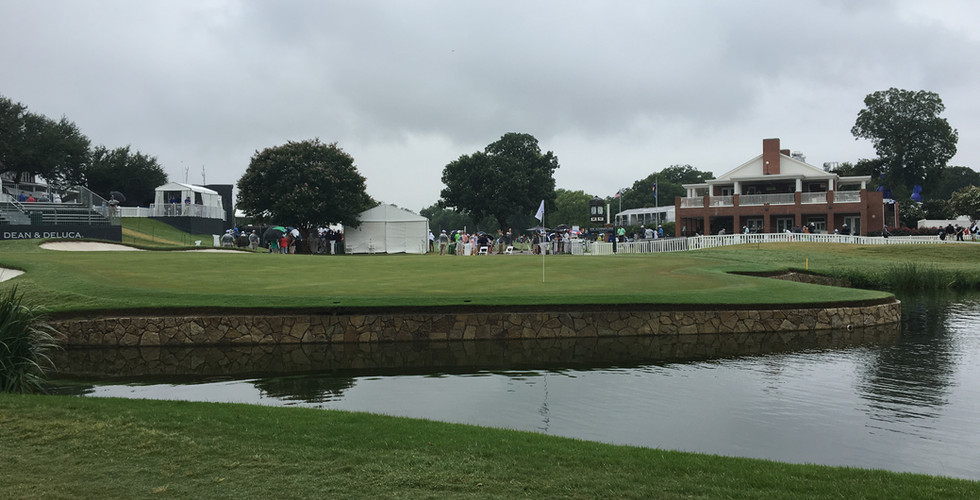The Art of The Greens
- featuring Trey Kemp of Colligan Golf Design
- Jun 1, 2017
- 6 min read
The art of the greens has been vital to the success and enjoyment of courses for the longest time. 75% to 80% of shots during the round involve the green yet so many people judge their merit by their speed and how green they are. Green speeds are expected to be at tournament speeds year round and when they aren't the complaining begins. While the speed of the greens is important, there are many more factors that attribute to their success. To help identify these factors, we asked golf course architect Trey Kemp of Colligan Golf what he considers when designing green complexes.
The approach shot into the green is a must when considering the green's design. The entrances and slopes leading into the green are often overlooked and not considered by the average player. The type of approach shot greatly impacts what the green complex will look like, Trey Kemp puts it like this:"The first thing that needs to be done is to route the golf course and that includes identifying each hole and all of the green sites. Once the routing has been established things like strategy, wind direction and length of approach shot are just a few of the things that are taken into account. Below are a few of the things we think about when designing greens: The green design should recognize a longer approach shot requires a more generous target. The shorter the approach shot, the more accuracy should be required. Therefore, the approach on a short Par-4 or Par-5 could have bunkers partially across the front of the green, while a long Par-4 would tend to have a more open approach shots could roll onto the green.The most severe approach shot is one with hazards in front of the green. A green with little depth to stop the ball is also severe and are usually limited to shorter holes. We always consider the average golfer before utilizing a shallow green or one with bunkers in front because a large segment of golfers can't consistently negotiate this type of hazard."
I recently played Texas Star in Euless, Texas and the one hole that has really stuck with me is the 11th (for the Course Profile click here).The hole is fairly short at 337 yards and gives players a number of options for attacking the green. Two bunkers guard the green and a shot left short can result in the ball rolling down the hill. The left half of the green tilts away from the player and has very little depth. This kind of green would be very difficult for the average player to manage with a long iron or wood, but given the short club in players can choose their line appropriately. This same style of green complex is also seen at Ridgewood Country Club's 2nd hole. The hole is fairly short at 355 yards. Players usually have around 100-125 yards into this green but it can be among the toughest shots they have all day. The green is pushed up a few feet and is guarded by two green side bunkers. Attacking the front pin is usually dangerous, the possibility of spinning it off the green and missing it in the green side bunkers makes it difficult to trust a shot. A back left pin has very similar possibilities and players must control their distance extremely well just to stay on the green (click here to view hole). The other side of the spectrum is the long approach shot and its effect on the green complex. The 9th hole at Diamondback Golf Club in Abilene shows these principles really well. The 448 yard hole offers much forgiveness to players as the front of the green is unguarded by bunkers (there is a bunker toward the back) and the fairway gently slopes up to the green. This hole offers great playability and still provides a challenge to the better player who want to take on the flag. The size of the greens are also dependent on wind direction, amount of play and maintenance.
Hazards around the green also play an important role in the design of a green complex. Bunkers around the green can serve as strategic factors or penal punishments for shots. When serving a strategic bunker, where they force players to position themselves, greens tend to vary in size and contouring. Perhaps a good example of this Crown Colony's 16th hole (to view the hole click here). The short par 5, only 481 yards, gives players the option of going over the creek that is around 80 yards from the green or laying up. A front right bunker guards the green and ideally a player wants to go over the creek to take the bunker out of play and have a shorter shot. Players who lay up will be left with a shot around 100 yards and must carry the bunker and hold a shot on the narrow green guarded by bunkers behind it as well. Water hazards also play an important role in determining the overall look of a green complex. Water hazards are the most penal hazards of all as when you hit it in them there is no playing out of it and a loss of a stroke. When laying out a course, architects are aware of this and design the hole accordingly. Very rarely do you see green complexes surrounded by water with other hazards added to the area. An example of this, however, is the 11th hole at Walden on Lake Conroe (to view hole click here). The green is surrounded by hazards and the green itself is contoured and laid out accordingly to reward a good shot. This hole, wether people like it or not, is a brutal test of ball striking and can determine good and bad ball strikers real quick.
Contours in the green are one of the most importance parts of the green complex. Trey Kemp says that "green contouring is one thing that can make or break a course in my opinion. All good greens have one thing in common and that is they are playable. Depending on the nature of the hole, some greens may be shaped and contoured with decks to emphasize the premium of getting close to the pin. By and large, the greens should be gently rolling. The premium for getting close to the pin will come from a shorter putt, which in itself increases the chances for a birdie." A lot of golfer can get caught up in looking at pictures of courses like Bandon Dunes or Streamsong and say that that is how greens should be and condemn greens like Kemp described. But those greens come from the nature of the course's property and its terrain. Courses more inland with those greens would look completely unnatural to the land and would create little success. Perry Maxwell is often said to be one of the best in terms of green complexes. I recently walked Colonial Country Club for the DEAN AND DELUCA Invitational and was in awe of the greens. The interior and exterior contours create such a simple surface and create numerous pin locations inside the green and on it's edges. PGA Tour player, Zac Blair, said this about the greens at Colonial when we asked him on Twitter: "The Colonial Greens are simple and great. Nothing tricked up about them, but they can get very fast when you get above the hole"... "you can have difficult putts. They rank pretty high as far as green complexes on tour", and "Another thing that is cool about them. They all seem to have a couple hole locations that can be pretty challenging to get close to"... "But again, they all seem to have a handful of friendly hole locations where you see a lot of close approaches." It's greens like these that standout and provide interesting play. Holes like 9 and 16 at Colonial are very open to pin locations but placement is key in setting up good looks. Shots into the green are also much more fun, where hitting the green doesn't always guarantee a two putt and lag putting becomes somewhat of a premium. Overall, hole locations need to be on a little flatter surface. Good shots need to be able to be rewarded and not given a 4 foot putt that breaks 2 feet.
Turf conditions play a huge role in green design. Traffic and drainage are huge factors in determining the finished green complex. Simple things go overlooked by a lot of players like where do players walk up to the green and leave the green (traffic, if their is only one place to enter and exit a green, the grass becomes very stressed like on island greens). Drainage is key to providing consistent turf conditions, an excess of moisture can increase chances of disease and algae growth. Simple things such as air movement and the amount of sunlight grass gets has a major impact on the design of greens to make them substainable. Creating surfaces that will maintain good playability and lower maintenance costs is common goal of architects.
C.B. Macdonald stated in his book, Scotland's Gift, that "Putting-greens to a golf course are what the face is to a portrait." Everything else is just an accessory to the green. In future articles about the art of the greens, we'll be showing more examples of some of the principles discussed.
Thanks for reading and remember to follow us on Twitter: @ga_texas and on Instagram: ga_texas. We also want to thank Trey Kemp for his input on the subject.










Comments